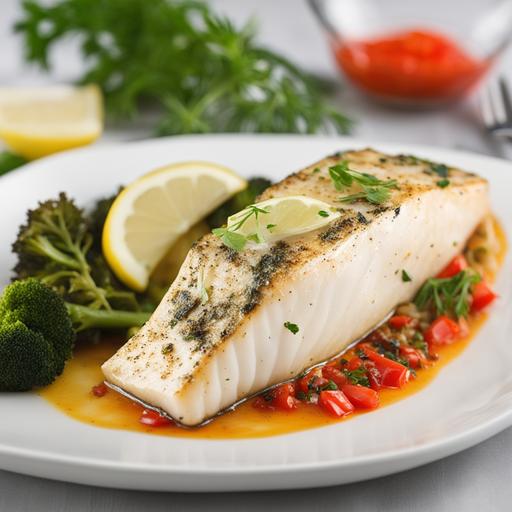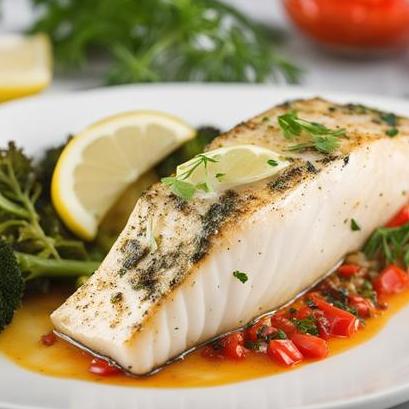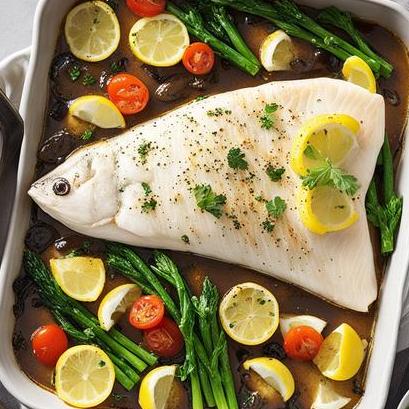
Halibut Oven Recipe: A Culinary Delight For Seafood Lovers
Are you a seafood enthusiast seeking a delectable and wholesome dish that will excite your taste buds? Look no further! In this comprehensive article, we will dive deep into the art of preparing a succulent Halibut dish using an oven. We will guide you through every aspect of this culinary delight – from the science behind cooking halibut to cleaning, preparation, tips, variations, and so much more. So, let’s embark on this flavorful journey together!
The Science of Cooking Halibut
Cooking halibut is not just about following a recipe, but understanding the delicate science behind it. This flatfish, known for its mild and delicate flavor, requires a gentle touch to ensure moist and tender results. Understanding the halibut’s protein composition and enzymes will help us master the art of cooking it to perfection.
Halibut contains a considerable amount of protein, primarily composed of myosin and actin. When cooked, these proteins denature and coagulate, leading to a firm and opaque texture. However, overcooking can cause these proteins to become tough and dry, resulting in an unpleasant eating experience. On the other hand, undercooking may leave the fish raw in the center. Achieving the ideal doneness is crucial to savoring the true flavors of this magnificent fish.
Selecting Fresh and Pristine Halibut
Before we dive into the cooking process, let’s talk about selecting the perfect halibut for your scrumptious dish. Whether you’re visiting your local fish market or grocery store, there are a few essential tips to keep in mind:
- Appearance: Choose halibut fillets that are glossy, firm, and free from any discoloration or browning.
- Smell: Fresh halibut should have a mild, clean, and slightly sweet odor. Avoid any fish with an overpowering fishy smell.
- Texture: Gently press the flesh to ensure it bounces back and holds its shape. This indicates freshness and quality.
- Sustainability: Consider choosing halibut that is marked as sustainably caught, to support environmentally friendly fishing practices.
By selecting the freshest halibut available, you set the stage for a truly exceptional culinary experience.
Cleaning and Preparing Halibut

Now that we have procured our prime halibut, it’s time to clean and prepare it for the oven. Follow these simple steps to ensure your fish is ready for the cooking process:
- Rinse: Rinse the halibut fillets under cold running water to remove any residual scales or debris.
- Pat Dry: Gently pat the fillets dry with paper towels to remove excess moisture. This step is crucial to achieving a crispy exterior.
- Skinning: If desired, you can remove the skin from the fillets using a sharp knife. However, leaving the skin intact adds flavor and protects the delicate flesh during cooking.
- Seasoning: Season the halibut fillets with salt and pepper or your preferred seasoning blend. Remember not to overpower the delicate natural flavors of the fish.
Properly cleaning and preparing the halibut ensures a pristine canvas for the flavors to harmonize during the cooking process.
Top Tips for Cooking Halibut in the Oven

Cooking halibut to perfection requires skill and attention to detail. Here are a few essential tips to elevate your culinary prowess:
- Preheating the Oven: Always preheat your oven to the desired temperature before placing the halibut inside. This ensures even cooking throughout.
- Oven Temperature: Set your oven temperature to 400°F (200°C) for a balance between gentle cooking and achieving a beautifully browned exterior.
- Cooking Vessel: Choose an oven-safe baking dish or sheet pan that comfortably accommodates the halibut fillets without overcrowding.
- Cooking Time: As a general guideline, aim to cook halibut for about 10-12 minutes per inch of thickness. Adjust the cooking time based on the specific recipe and your desired level of doneness.
- Basting: Basting the halibut with melted butter or a marinade during the cooking process can enhance the flavors and ensure moistness.
- Resting Period: Allow the cooked halibut to rest for a few minutes before serving. This allows the juices to redistribute within the fish, resulting in a more succulent bite.
By following these tips, you will achieve a perfectly cooked halibut dish that will impress your friends and family.
Recipe: Oven-Baked Herb-Crusted Halibut

Now that we have covered the essential details of selecting, cleaning, and cooking halibut, let us dive into an incredibly flavorsome recipe that will undoubtedly become a family favorite. This Herb-Crusted Halibut combines the delicate flavors of the fish with aromatic herbs, creating a culinary masterpiece.
Ingredients:
- 4 halibut fillets (6 ounces each)
- 2 tablespoons olive oil
- 2 tablespoons fresh lemon juice
- 1 tablespoon minced garlic
- 1 teaspoon dried thyme
- 1 teaspoon dried basil
- Salt and pepper to taste
Instructions:
- Preheat your oven to 400°F (200°C).
- In a small bowl, combine the olive oil, lemon juice, minced garlic, dried thyme, dried basil, salt, and pepper. Mix well to create a flavorful marinade.
- Place the halibut fillets in a baking dish or a sheet pan, ensuring they are evenly spaced.
- Drizzle the prepared marinade over the fillets, coating them thoroughly on both sides.
- Let the halibut marinate for 15-20 minutes, allowing the flavors to permeate the fish.
- Once marinated, place the baking dish in the preheated oven and let the halibut cook for approximately 10-12 minutes per inch of thickness, or until the fish flakes easily with a fork.
- While cooking, baste the halibut with the marinade every few minutes to ensure moistness and enhance the flavors.
- Once cooked, remove the halibut from the oven and let it rest for a few minutes before serving.
- Garnish with fresh herbs, a squeeze of lemon juice, and serve alongside your choice of sides.
Checking for Doneness: Undercook or Overcook?

It’s vital to attain the perfect level of doneness when cooking halibut. Overcooking or undercooking can significantly impact the taste and texture of the fish. Here’s how you can check for doneness:
- Flake Test: Gently insert a fork or the tip of a knife into the thickest part of the halibut. If the fish flakes easily and appears opaque, it’s perfectly cooked. Avoid overcooking, as the halibut will become dry and less flavorful.
- Temperature: Use an instant-read thermometer to measure the internal temperature of the fish. The halibut should reach an internal temperature of 145°F (63°C). Remember that carryover cooking will cause the temperature to rise a few degrees during the resting period.
By employing these doneness checks, you’ll achieve the ideal level of tenderness, moistness, and flavor in your halibut dish.
Variations and Culinary Creativity
While the Herb-Crusted Halibut recipe provides a delightful culinary experience, don’t shy away from experimenting with various flavor profiles and cooking techniques. Here are a few creative variations to ignite your imagination:
- Citrus Infusion: Replace the lemon juice in the marinade with lime, orange, or a combination of citrus fruits for a refreshing twist.
- Herb Medley: Venture beyond thyme and basil by incorporating other aromatic herbs such as parsley, dill, or rosemary.
- Panko Crunch: Substitute the herb crust with a crispy panko breading for an irresistible texture contrast.
- Grilled Perfection: Opt for grilling instead of baking for a smoky flavor infusion. Ensure a clean and well-oiled grill to prevent the delicate halibut from sticking.
Let your culinary creativity soar as you delight in the versatility of this remarkable fish.
Conclusion
As we conclude this comprehensive journey into the world of halibut oven cooking, we hope you feel inspired and well-equipped to create an exceptional culinary experience. Understanding the science behind cooking halibut, selecting pristine ingredients, and following our informative tips and recipe will undoubtedly result in a delightful and flavorful dish.
Remember, cooking is an art, and practice and experimentation are key to mastering any recipe. So, don your apron, sharpen those culinary skills, and embark on an exquisite adventure, as you prepare the tantalizing Halibut Oven Recipe. Enjoy the journey, and bon appétit!
Sources
FAQS On Halibut Oven Recipe
What Temperature Should I Preheat The Oven For Cooking Halibut?
Preheat the oven to 400 degrees Fahrenheit to ensure even and thorough cooking of the halibut.
How Long Should I Bake The Halibut In The Oven?
Depending on the thickness of the halibut fillets, bake them for about 10-15 minutes or until the flesh is opaque and easily flakes with a fork.
What Are Some Seasoning Options For A Halibut Oven Recipe?
You can season the halibut with a variety of herbs and spices such as garlic, parsley, lemon zest, paprika, and black pepper. You can also use a simple combination of salt and pepper for a more subtle flavor.
Should I Cover The Halibut With Foil While Baking In The Oven?
It is not necessary to cover the halibut with foil while baking in the oven. However, if you prefer to keep the fish moist, you can loosely cover it with foil for the first half of the cooking time.
How Can I Tell If The Halibut Is Cooked Through In The Oven?
The easiest way to tell if the halibut is cooked through is to use a fork to gently flake the flesh. If the flesh easily flakes and is opaque, then the halibut is ready to be removed from the oven.


